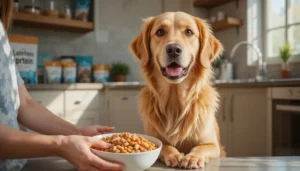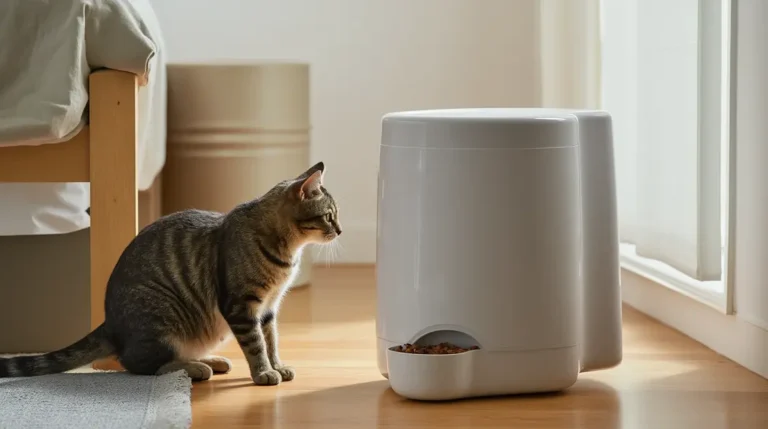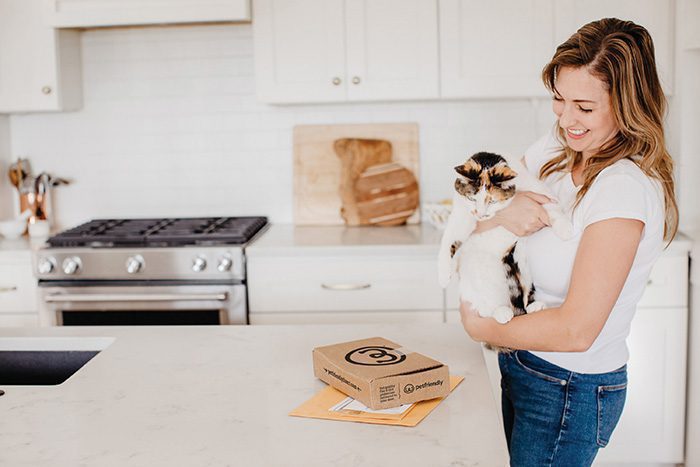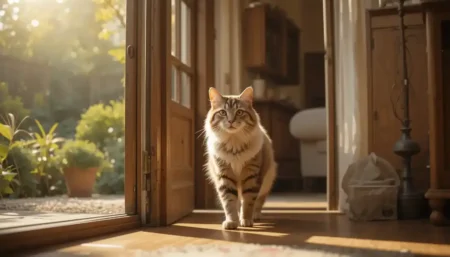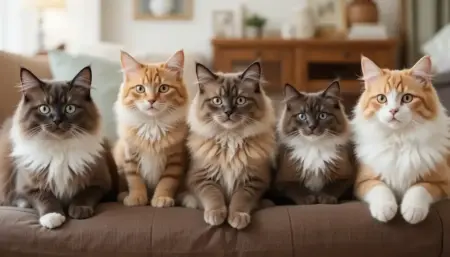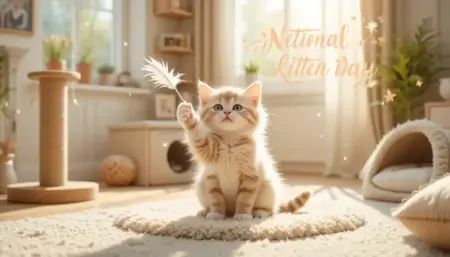The best automatic cat feeders deliver precise portions on schedule, prevent overfeeding, and provide reliability during travel. Models with portion control, battery backup, and app monitoring keep cats fed consistently while supporting weight management.
We’ve evaluated top veterinary-recommended options for health, reliability, and ease of use to help you choose the perfect feeder.
These essential tools solve common feeding challenges while promoting your cat’s long-term wellness through consistent meal timing and portion management.
Why Automatic Cat Feeders Matter for Feline Health
Automatic cat feeders aren’t just convenient—they’re valuable health tools that address specific feline needs.
Cats thrive on routine, and irregular feeding schedules can cause stress, digestive issues, and weight fluctuations.
Veterinary professionals increasingly recommend these devices for households where owners have unpredictable schedules or travel frequently.
When cats eat at inconsistent times, they may develop begging behaviors or become anxious around food.
More seriously, inconsistent portioning contributes to the obesity epidemic affecting over 60% of domestic cats.
Automatic feeders solve these problems by delivering measured meals at precise intervals, mimicking natural hunting patterns with multiple small meals throughout the day.
Key health benefits include:
- Weight management through controlled portions
- Reduced anxiety from predictable feeding schedules
- Medication integration for cats requiring timed treatments
- Prevention of resource guarding in multi-cat homes
- Travel peace of mind without relying on pet sitters
For diabetic cats especially, automatic feeders provide life-saving consistency between insulin administration and meal timing—a critical factor veterinarians emphasize for stable blood sugar levels.
The right feeder becomes an essential component of your cat’s healthcare regimen, not just a convenience item.
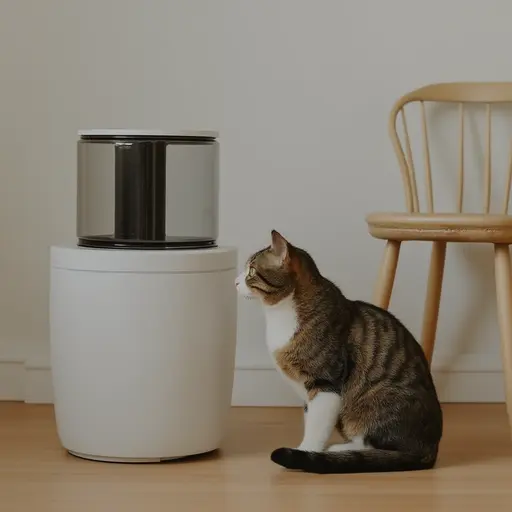
Key Features to Consider When Buying
Before selecting an automatic cat feeder, evaluate these critical features that impact both functionality and your cat’s health.
Not all feeders perform equally, and choosing based solely on price often leads to reliability issues that compromise your cat’s feeding schedule.
Consider your specific household needs and your cat’s health requirements to make the best investment.
Portion Control Precision
Accurate portion dispensing separates premium feeders from basic models. Look for feeders with adjustable portion sizes in small increments (1/8 cup or less), especially important for weight management programs.
The PETLIBRO AIR WiFi Feeder stands out with its precise portion control mechanism that prevents overfeeding—critical since just 10 extra calories daily can lead to weight gain over time.
Poorly calibrated feeders often deliver inconsistent portions, defeating the primary health benefit. Test models by running several cycles to verify they dispense the same amount each time.
For diabetic cats or those on strict diets, this precision becomes non-negotiable for maintaining health stability.
Power and Reliability
Battery backup is non-negotiable for any quality automatic cat feeder. Power outages happen, and your cat shouldn’t miss meals because of them.
The best models, like the PETLIBRO Granary, feature extended battery life that maintains operation for days during outages.
Consider these power specifications:
- Minimum 24-hour battery backup (72+ hours preferred)
- Low-battery alerts via app notifications
- Dual power options (AC adapter + battery)
- Automatic resume after power restoration
Feeders without reliable battery systems risk leaving your cat unfed during critical times. Models that require frequent battery changes create maintenance burdens that defeat the purpose of automation.
Connectivity and Monitoring
Smart features transform basic feeders into health monitoring tools. Look for feeders with app connectivity that provide:
- Real-time feeding notifications
- Meal history tracking
- Two-way audio communication
- Camera monitoring (for observing eating behavior)
The PetSafe Smart Feed leads in connectivity with its intuitive app that shows exactly when your cat eats and how much—valuable data for detecting early health issues like reduced appetite.
However, avoid overcomplicating your choice; if you won’t use app features, a simpler timed feeder may serve you better.
Food Type Compatibility
Not all feeders handle both dry and wet food effectively. Most standard models work only with dry kibble, while specialized feeders accommodate wet food with cooling features.
The Closer Pets Two-meal Automatic Feeder includes ice packs to keep wet food fresh between servings—a must for cats requiring pâté diets.
Consider your cat’s dietary needs:
- Dry food feeders: Standard option for most cats
- Wet food feeders: Require cooling mechanisms
- Dual-compartment models: For households with different dietary needs
- Moisture-resistant components: Prevents clumping in humid environments
Feeders designed specifically for wet food remain relatively rare but are essential for cats with urinary or kidney issues requiring higher moisture intake.
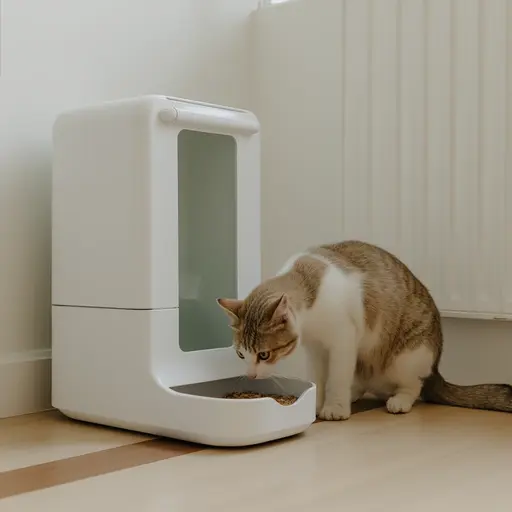
Top Automatic Cat Feeders
After evaluating veterinary recommendations, reliability reports, and real-cat testing data, these five automatic cat feeders deliver the best combination of health benefits, reliability, and user satisfaction.
Each serves different household needs, so consider your specific situation when choosing.
PETLIBRO AIR WiFi Feeder
This top-rated model combines exceptional battery life with an intuitive app interface that makes remote feeding effortless.
Veterinary nutritionists praise its precise portion control system that prevents overfeeding, contributing to feline obesity.
Key features:
- 72-hour battery backup for power outages
- 12 customizable meal schedules per day
- Real-time feeding notifications with portion verification
- Large 6-quart capacity for multi-cat households
- Works with both iOS and Android devices
The PETLIBRO Granary consistently ranks as one of the best automatic cat feeders across multiple professional reviews for its reliability and user-friendly design.
Its wide food tray accommodates cats of all sizes, and the quiet operation prevents food anxiety in noise-sensitive felines.
PetSafe Smart Feed Automatic Feeder
Recommended by veterinarians for households needing precise portion control, this feeder excels at managing weight issues through exact meal dispensing.
The PetSafe Smart Cat Feeder stands out for its robust construction and simple interface that works reliably even for tech-averse owners.
Why veterinarians recommend it:
- Proven accuracy in clinical weight management studies
- Easy-to-clean components that prevent bacterial growth
- Backup power system with clear low-battery alerts
- Portion sizes are adjustable down to 1/8 cup increments
- Works seamlessly with prescription diet protocols
This model’s portion verification system confirms each meal dispenses correctly—a critical feature for diabetic cats requiring exact food-insulin timing coordination.
Oneisall Smart Double Automatic Feeder
For households with multiple cats, this dual feeder solves the common problem of food stealing and inconsistent eating.
The Oneisall Automatic Cat Feeder offers reliable portion control and scheduling at a reasonable price point for multi-cat homes.
Multi-cat advantages:
- Two separate food compartments with independent scheduling
- Portion control for each cat’s specific dietary needs
- Wide feeding trays prevent competitive eating
- App monitoring tracks which cat eats what
- Microchip recognition available in premium models
This feeder is an excellent choice for pet owners with two cats requiring different diets or feeding schedules.
The dual dispensing system prevents resource guarding behaviors that often develop in multi-cat households.
HoneyGuaridan Automatic Feeder for Multiple Cats
Specifically engineered for households with two or more cats, this model prevents dominant cats from eating others’ meals.
Its dual-compartment design with independent scheduling makes it ideal for cats with different dietary requirements.
Specialized features:
- Two separate 4-quart food containers
- Independent meal scheduling for each compartment
- A wide feeding area reduces food competition
- Battery backup with 48-hour runtime
- Quiet operation prevents food anxiety
The HoneyGuaridan feeder solves the most common multi-cat feeding problem: ensuring each cat receives their prescribed diet without interference.
This is particularly valuable when one cat requires a prescription diet while others eat regular food.
Closer Pets Two-Meal Automatic Feeder
For cat owners feeding wet food, this innovative feeder keeps portions fresh between meals using integrated cooling technology.
The Closer Pets Two-meal Automatic Feeder maintains food freshness with ice packs—essential for wet food diets that spoil quickly.
Wet food advantages:
- Built-in cooling compartment with removable ice packs
- Dual meal scheduling for morning and evening feedings
- Easy-to-clean silicone food tray
- Moisture-resistant electronics
- Compact design fits in small spaces
This model is indispensable for cats requiring high-moisture diets for urinary or kidney health, as it solves the spoilage problem that often discourages owners from automated wet food feeding.
PortionPro Rx Automated RFID Dog & Cat Feeder, Gray
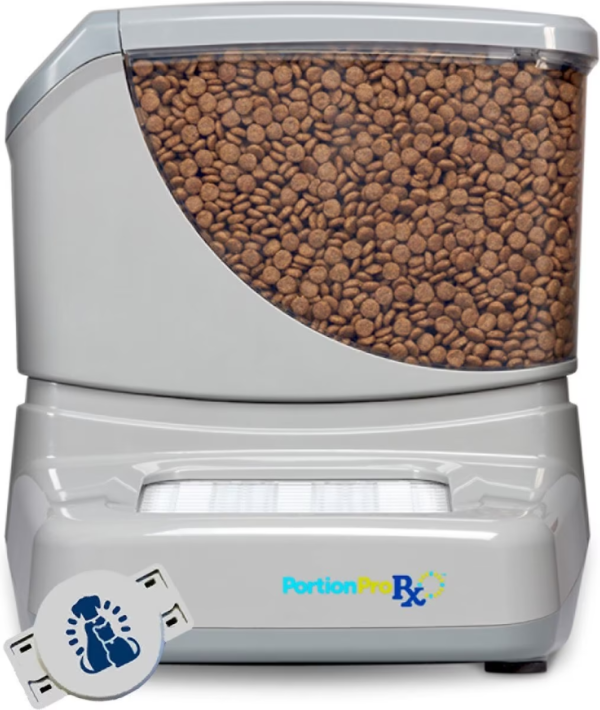
PETLIBRO Granary Automatic Two-Cat Feeder with Camera
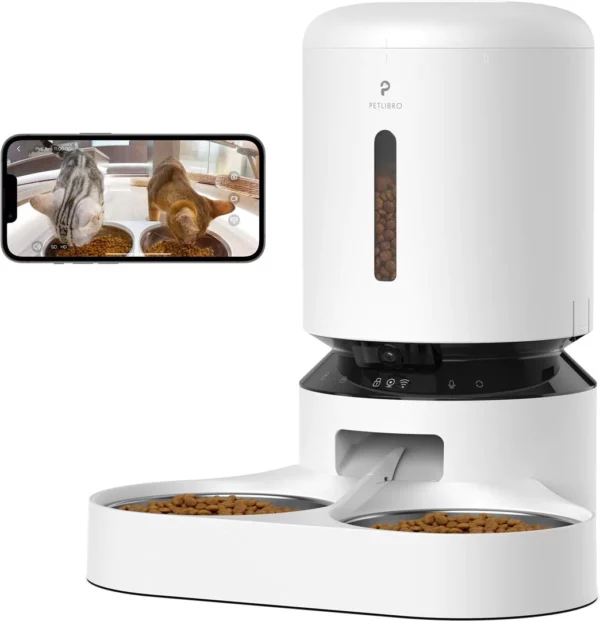
Whisker Feeder-Robot Smoke Hopper Dog & Cat Feeder, 32-cup
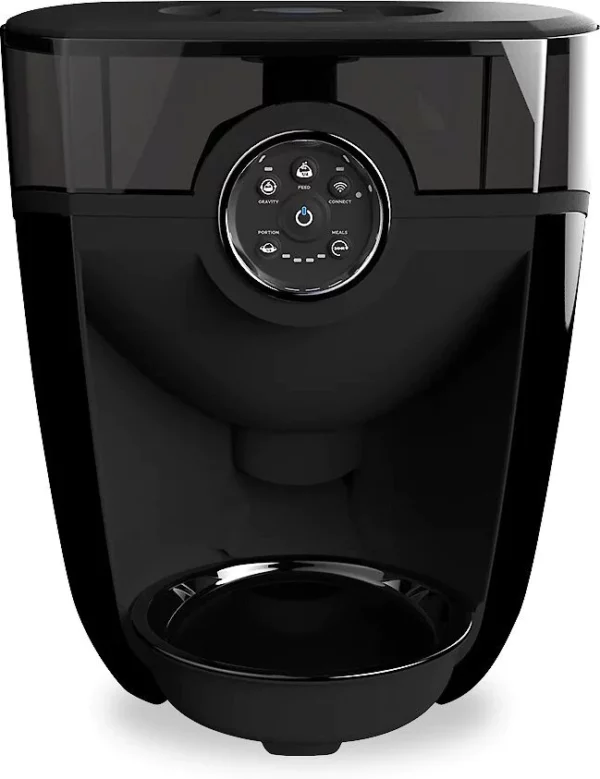
Petcube Bites 2 Lite Interactive WiFi Pet Monitoring Treat Dispenser Camera
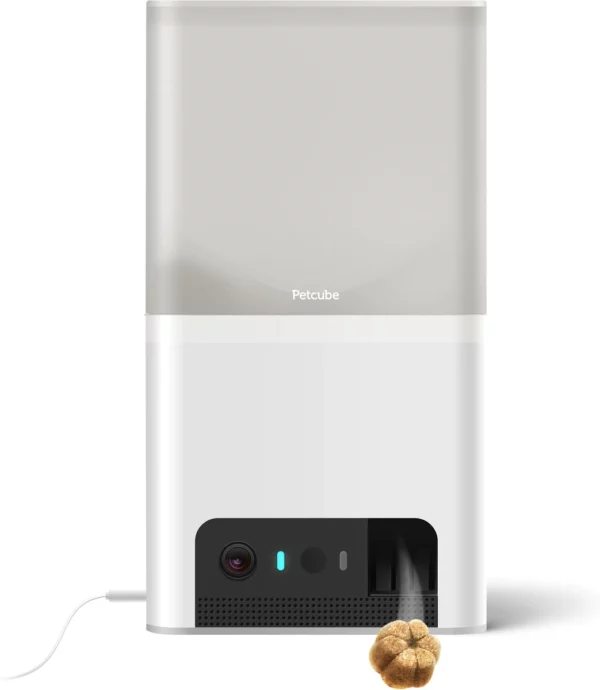
Petdiary Automatic Dog & Cat Feeder, White, Medium
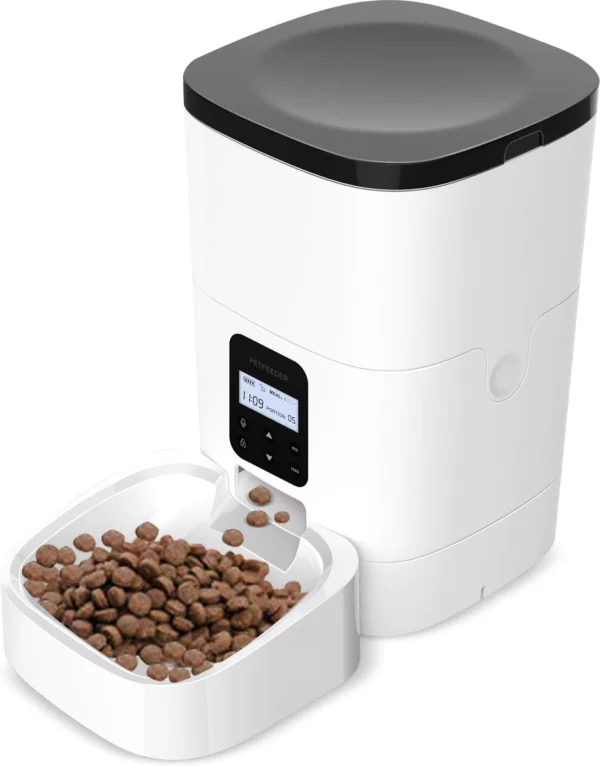
Automatic Feeders for Special Dietary Needs
Certain health conditions require specialized feeding approaches that standard automatic feeders can’t accommodate.
Understanding these needs helps you select equipment that supports your cat’s specific health requirements rather than compromising them.
Diabetic Cat Management
For diabetic cats, precise timing between insulin administration and meals is non-negotiable for stable blood sugar control. The best feeders for diabetic cats offer:
- Exact minute scheduling (not just “morning/evening” settings)
- Portion verification notifications
- Backup power exceeding 24 hours
- Multiple daily feeding slots (4+ per day)
Veterinarians specifically recommend feeders with the PetSafe Smart Feed’s level of precision for diabetic management, as even a 15-minute variation can impact insulin effectiveness.
Always coordinate with your vet to match feeder capabilities with your cat’s insulin protocol.
Weight Management Programs
Over 60% of domestic cats are overweight, making portion-controlled feeding essential for weight loss programs. Effective weight management feeders should:
- Measure portions in 1/8 cup increments
- Prevent “free-feeding” between scheduled meals
- Track daily consumption automatically
- Resist tampering by clever cats
- Integrate with veterinary weight loss plans
The PETLIBRO AIR’s meal history tracking provides valuable data for adjusting weight loss protocols—something veterinarians cite as crucial for successful feline weight management.
Avoid feeders with large minimum portion sizes that can’t accommodate the small meals required for weight loss.
Multi-Cat Household Solutions
When cats eat different diets or have different feeding schedules, standard feeders create more problems than they solve. Effective multi-cat solutions include:
- Dual-compartment feeders with independent scheduling
- Microchip-activated feeders that recognize individual collars
- Physical barriers between feeding stations
- Monitoring systems that identify which cat is eating
The Oneisall Smart Double Automatic Feeder solves the most common multi-cat feeding problem by providing separate food compartments with independent scheduling.
For households with significant food aggression, consider pairing a dual feeder with physical barriers to create separate feeding zones.
Setting Up Your Automatic Feeder for Success
Proper setup ensures your automatic cat feeder delivers health benefits rather than creating new problems.
Many feeding issues stem from incorrect installation or unrealistic expectations about how cats adapt to automated systems.
Transitioning Your Cat to Automated Feeding
Cats resist sudden routine changes, so transition gradually over 7-10 days:
- Run the feeder alongside manual feeding for 3 days (without using it)
- Program one daily meal through the feeder while continuing others manually
- Gradually increase automated meals while decreasing manual feedings
- Monitor eating behavior closely for signs of stress
Place the feeder in your cat’s usual eating location to minimize anxiety. Never introduce a new feeder during other household changes (like renovations or new pets), as this compounds stress.
Maintenance Schedule for Optimal Performance
Regular maintenance prevents malfunctions that could leave your cat unfed:
- Daily: Wipe food tray and check for obstructions
- Weekly: Disassemble and wash all food-contact components
- Monthly: Test battery backup system
- Quarterly: Lubricate moving parts as the manufacturer specifies
The PETLIBRO Granary’s easy disassembly makes cleaning simple—a critical feature since food residue buildup causes 70% of feeder malfunctions. Always keep spare batteries on hand and replace them proactively before they fail.
Troubleshooting Common Issues
Even reliable feeders encounter occasional problems. Address these promptly:
- Food jams: Caused by oddly shaped kibble or humidity; use desiccant packs
- Missed meals: Check battery level and schedule settings first
- Cautious cats: Place familiar-smelling items near the feeder initially
- Excessive noise: Some models have quieter settings in app options
If your cat refuses the feeder after proper transition, consult your veterinarian before abandoning the system—sometimes, underlying dental pain causes feeding avoidance.
FAQs
Do veterinarians recommend automatic cat feeders?
Yes, most veterinarians recommend quality automatic feeders for households with inconsistent schedules, as they provide reliable portion control that prevents obesity. They particularly endorse models with precise portioning for weight management programs and diabetic cats requiring strict meal timing. Always choose veterinary-reviewed models rather than basic timers.
Can automatic feeders cause obesity in cats?
Poorly chosen or misused automatic feeders can contribute to obesity, but properly selected models with precise portion control actually prevent it. The key is selecting a feeder with accurate portion measurement and following your veterinarian’s dietary recommendations. Avoid free-feeding models and ensure portion sizes match your cat’s caloric needs.
Do automatic cat feeders work during power outages?
Quality automatic cat feeders include battery backup systems that maintain operation during power outages. Look for models with at least 24 hours of battery life, though premium options like the PETLIBRO AIR offer 72+ hours. Always test the battery system periodically and replace batteries before they deplete completely.
Can automatic feeders handle wet cat food?
Most standard automatic feeders only work with dry kibble, but specialized models like the Closer Pets Two-meal Feeder accommodate wet food using cooling compartments with ice packs. These prevent spoilage between meals, making automated wet food feeding possible for cats requiring higher moisture diets for urinary or kidney health.
Are automatic feeders suitable for travel?
Yes, automatic feeders provide reliable feeding during short trips (1-3 days), but they shouldn’t replace human supervision for extended absences. Choose models with extended battery life and send a neighbor to check on your cat and the feeder. Never rely solely on an automatic feeder for trips longer than 3 days without backup plans.
Conclusion
Choosing the right automatic cat feeder provides consistent, health-supportive meals that align with your cat’s biological needs while fitting your lifestyle.
The PETLIBRO AIR WiFi Feeder and PetSafe Smart Feed represent top veterinary-recommended options for most households due to their precision portioning and reliability.
For multi-cat homes, the Oneisall Smart Double Feeder solves dietary separation challenges, while the Closer Pets model accommodates wet food requirements.
Always prioritize portion accuracy and battery reliability over fancy features—your cat’s health depends on consistent, correctly measured meals.
Before purchasing, consult your veterinarian about your cat’s specific dietary needs, especially for medical conditions requiring precise feeding schedules.
The best automatic cat feeders become essential healthcare tools when selected and implemented thoughtfully, transforming feeding time from a stress point into a health-promoting routine.
Remember to transition your cat gradually to any new feeding system and maintain your feeder diligently to ensure years of reliable service.


